We’ve tested so many cordless drills over the years that we’ve lost count. At one point, we filled our shop with 50 drills at one time for an epic shootout. We nearly lost our video editor over that one, but we also learned a lot. For this article, we focused on the top brands and brought back the top contenders for a fresh round of head-to-head testing to determine which flagship model is the best cordless drill in 2024.
Want to watch our head-to-head testing? Check out our best cordless drill video!
Our Top Picks for Best Cordless Drill
Every Model We Tested
Also In This Article
Final Ratings
Best Cordless Drill Overall | Best Lightweight Cordless Drill | Best Compact Cordless Drill
Milwaukee M18 Fuel Hammer Drill (Gen 4) 2904

- Speeds: 0 – 500/2,100 RPM
- Max Hammer Rate: 33,000 BPM
- Max Torque: 1,400 in-lbs
- Length: 7.1 inches
- Weight: 3.2 lbs bare, 4.9 lbs with a 5.0Ah battery, 5.7 lbs with a 6.0Ah High Output battery
| 5.0Ah Battery (vs Primary Batteries Only) |
6.0Ah High Output Battery (vs Primary and Advanced Batteries) |
|
| Soft Torque | 539 in-lbs (2nd place) | 593 in-lbs (2nd place) |
| Spade Bit | 3.36 sec (5th place) | 2.62 sec (3rd place) |
| Self-Feed Bit | 2.59 sec (3rd place) | 2.21 sec (3rd place) |
| Concrete Bit | 3.74 sec (3rd place) | 3.38 sec (4th place) |
After tallying up the results, Milwaukee takes home three significant accolades, including our pick as the best cordless drill overall. There’s some push and pull here, though. The only area Milwaukee ranked first in was length. However, it’s the holistic look that makes the 2904 so compelling.
First of all, there are lighter drills in the DIY and Prosumer categories, but Milwaukee does take the top spot for Professional models. The trade-off here is that it’s with a 5.0Ah battery. If you want Milwaukee’s top performance, you need to switch over to the 6.0Ah High Output or Forge batteries, and they both bump up the weight.
Considering Milwaukee’s lowest ranking was 5th with a 5.0Ah battery and 4th with a High Output pack, it’s a contender in performance, though. Features such as the kickback control that’s new to this model, plus the massive width of Milwaukee’s M18 platform, and a solid 5-year warranty help solidify the 2904 as our top selection.
This model is also available with One-Key as model 2906.
Price: $299
Best Cordless Drill Performance
Flex 24V Brushless Hammer Drill with Turbo Mode FX1271
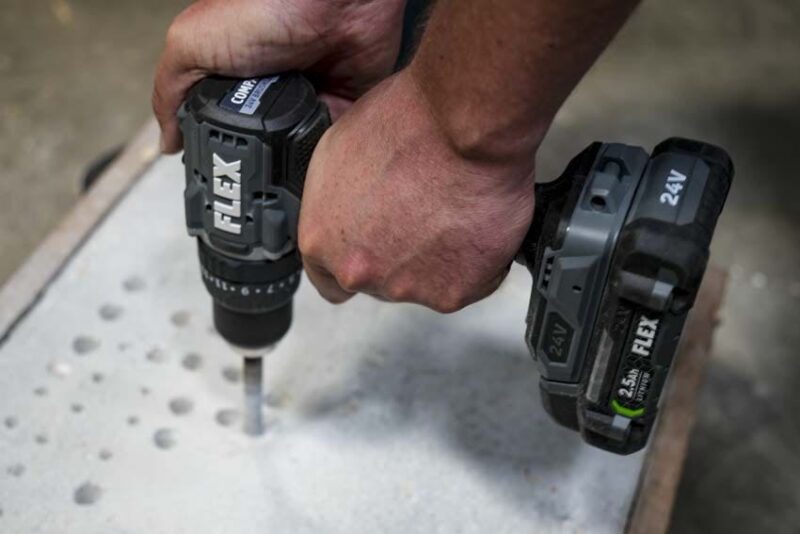

- Speeds: 0 – 700/2,500 RPM
- Max Hammer Rate: 32,000 BPM
- Max Torque: 1,400 in-lbs
- Length: 7.3 inches
- Weight: 3.8 lbs bare, 5.9 lbs with a 5.0Ah battery, 6.1 pounds with a 6.0Ah Stacked Lithium battery
| 5.0Ah Core18V Battery (vs Primary Batteries Only) |
6.0Ah Stacked Lithium Battery (vs Primary and Advanced Batteries) |
|
| Soft Torque | 425 in-lbs (6th place) | 549 in-lbs (3rd place) |
| Spade Bit | 2.82 sec (3rd place) | 2.44 sec (2nd place) |
| Self-Feed Bit | 4.74 sec (6th place) | 2.47 sec (5th place) |
| Concrete Bit | 3.44 sec (2nd place) | 2.55 sec (1st place) |
Flex launched its 24V line with this hammer drill and it continues to be a top-performing model several years in. Its high speed and high torque ratings showed in our testing where it earned the highest overall performance rating. There’s a caveat, though. That’s with using the 6.0Ah Stacked Lithium battery. If you’re a Pro, going with the Stackled Lithium kit is without a doubt the way to go.
It’s not just about speed and torque for Flex. This is a full-featured drill that includes kickback control and the ability to turn the Turbo mode off when you’d like more control.
When you take away Flex’s Stacked Lithium advantage, Bosch’s GSB18V-1330CN is your next best bet. Technically, the Core18V 6.3Ah battery we tested with is an advanced battery, but it’s so common on today’s Bosch cordless tools that it’s effectively the standard pack.
Price: $219
Best Cordless Hammer Drill for Concrete Drilling
Metabo 18V Brushless Hammer Drill BS 18 LTX-3 BL Q I


- Speeds: 0 – 450/2,000/4,000 RPM
- Max Hammer Rate: 38,000 BPM
- Max Torque: 1,151 in-lbs
- Length: 9.8 inches
- Weight: 3.9 lbs bare, 6.1 lbs with an 8.0Ah LiHD battery
| 8.0Ah LiHD Battery (vs Primary Batteries Only) |
8.0Ah LiHD Battery (vs Primary and Advanced Batteries) |
|
| Soft Torque | 430 in-lbs (4th place) | 430 in-lbs (7th place) |
| Spade Bit | 2.20 sec (1st place) | 2.20 sec (1st place) |
| Self-Feed Bit | 6.68 sec (9th place) | 6.68 sec (12th place) |
| Concrete Bit | 2.60 sec (1st place) | 2.60 sec (2nd place) |
Metabo’s SB 18 LTX BL I continues to carry the torch as the best hammer drill for concrete drilling in our tests. Its 3800 RPM top speed plays a big part in that.
There are some trade-offs to consider, though. This is a beefy drill and the largest we tested. For many applications that won’t be a bother, but if you’re used to working in tight spaces, you’ll want to look at something else.
Another consideration is that this model is great at low- to medium-load applications but more middle-of-the-road as the load gets heavy. It’s certainly capable of doing almost any job you’d ask of your hammer drill, but there are better ones if you frequently dive into heavy-load jobs.
Still, you’ll be hard-pressed to find a hammer drill that enjoys the high level of quality Metabo packs into their flagship hammer drill.
Price: $449.99
Best DIY/Prosumer Cordless Drill for Home Use
Ryobi 18V One+ HP Brushless Hammer Drill PBLHM101
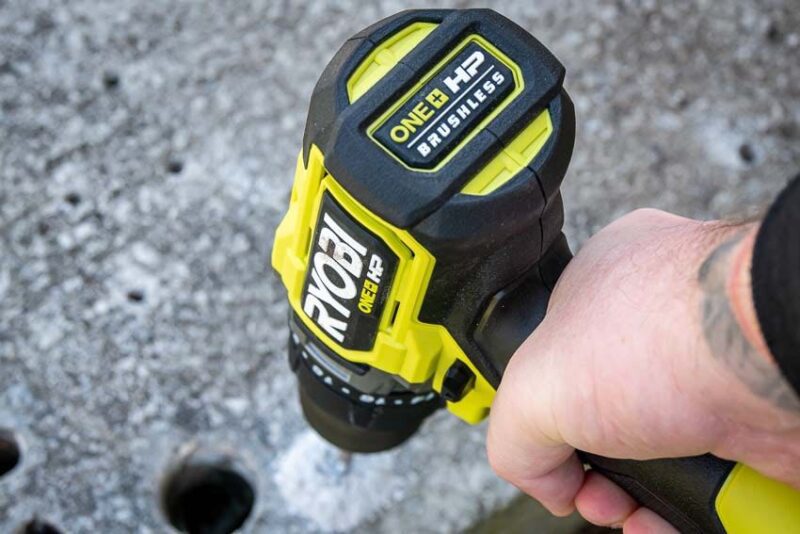

- Speeds: 0 – 500/2,100 RPM
- Max Hammer Rate: 31,000 BPM
- Max Torque: 750 in-lbs
- Length: 7.5 inches
- Weight: 3.0 lbs bare, 4.6 lbs with a 4.0Ah High Performance battery
| 4.0Ah High-Performance Battery (vs Primary and Advanced Batteries) |
4.0Ah High-Performance Battery (vs Primary and Advanced Batteries) |
|
| Soft Torque | 266 in-lbs (11th place) | 266 in-lbs (14th place) |
| Spade Bit | 3.92 sec (11th place) | 3.92 sec (14th place) |
| Self-Feed Bit | 6.93 sec (12th place) | 6.93 sec (15th place) |
| Concrete Bit | 4.16 sec (6th place) | 4.16 sec (9th place) |
As the HP Brushless lineup rolled out for Ryobi, one of the big things we noticed was how much smaller many of the tools are. That’s the case for their flagship hammer drill sitting at a mid-range 7.5 inches long and well under 5 pounds with a battery. It’s a big change for a brand that used to be on the bigger, heavier side of the conversation.
Boasting the lowest-rated torque of the group (Craftsman is likely lower, but reports UWO instead), its results weren’t surprising. The drill had no trouble completing our tests, though, and it is easier to handle than some of the larger, heavier models we tested.
Competing in the DIY/Prosumer class, it’s a very good choice based on its performance and design. What makes it more compelling than its competitors is that Ryobi now has more than 300 products that all work on any 18V One+ battery. Chances are, if you need it Ryobi has it. And if they don’t, most likely no one else in the Prosumer class does, either.
Price: $179
The Rest of the Best Cordless Drills
Bosch 18V Profactor Brushless Hammer Drill GSB18V-1330CN


- Speeds: 0 – 550/2,200 RPM
- Max Hammer Rate: 30,000 BPM
- Max Torque: 1,300 in-lbs
- Length: 8.3 inches
- Weight: 4.2 lbs bare, 5.9 lbs with a Core18V 6.3Ah battery
| 6.3Ah Core18V Battery (vs Primary Batteries Only) |
6.3Ah Core18V Battery (vs Primary and Advanced Batteries) |
|
| Soft Torque | 514 in-lbs (3rd place) | 514 in-lbs (5th place) |
| Spade Bit | 3.39 sec (6th place tie) | 3.39 sec (9th place) |
| Self-Feed Bit | 2.18 sec (2nd place) | 2.18 sec (2nd place) |
| Concrete Bit | 3.78 sec (4th place) | 3.78 sec (7th place) |
Bosch proved its flagship hammer drill to be a solid all-around performer. Its strong performance got better as the load increased, and it was certainly no slouch in the low and medium-load tests. From a performance perspective, there’s no reason to shy away from it, and current Bosch users shouldn’t feel like they need to switch brands.
The downside is that this is a larger, heavier hammer drill compared to the others. Keep in mind that Bosch’s 18V line is robust, and there are more compact models you can gran as a supplement when you’re working on lighter-duty days.
Three key features help Bosch stand out from the competition. It’s one of the few that has kickback protection. You can also turn it into a smart tool by adding the Connected Module. It’s also the only model in our test group that includes an electronic angle detection function to help you drill and drive straighter.
Price: $299
DeWalt 20V Max FlexVolt Advantage Brushless Hammer Drill DCD999
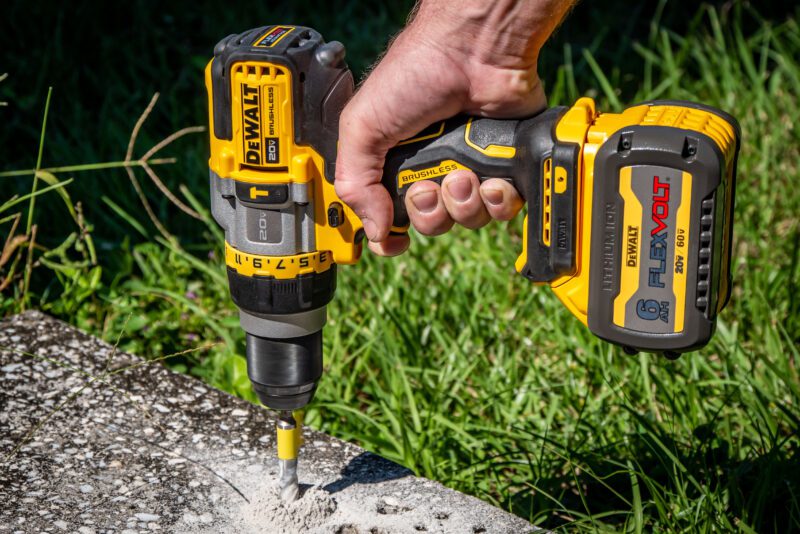

- Speeds: 0 – 450/1,300/2,000 RPM (0 – 500/1,500/2,250 RPM in hammer drilling mode)
- Max Hammer Rate: 38,250 BPM
- Max Power: 1,219 UWO
- Length: 8.4 inches
- Weight: 3.6 lbs bare, 4.9 lbs with a 5.0Ah battery, 5.9 lbs with a 6.0Ah FlexVolt battery
| 5.0Ah Battery (vs Primary Batteries Only) |
6.0Ah FlexVolt Battery (vs Primary and Advanced Batteries) |
|
| Soft Torque | 380 in-lbs (8th place) | 468 in-lbs (6th place) |
| Spade Bit | 3.39 sec (6th place tie) | 2.73 sec (5th place) |
| Self-Feed Bit | 3.58 sec (5th place) | 2.31 sec (4th place) |
| Concrete Bit | 4.18 sec (7th place) | 2.85 sec (3rd place) |
If you’re shopping at the top of DeWalt’s drill lineup, there are four models to wade through. You won’t go wrong with the DCD996, DCD997, DCD998, or the highest performer, the DCD999. Similar in size and weight, it’s all about what battery you’re primarily going to use (and if you want Tool Connect for the DCD997).
To get the highest performance from the FlexVolt Advantage, you need to use a FlexVolt battery, and that significantly increases both the size and weight. It also has good performance when you’re using a standard 5.0Ah battery. However, it’s like having two different tools because of how much the FlexVolt battery boosts performance—something you can see in our test results.
With a 6.0Ah FlexVolt battery, this drill pushes close to 6 pounds. Moreover, it’s one of the longer models, so it’s not ideal for tight spaces. DeWalt has a wide range of drills to choose from, so you can always pick up a compact supplement when you need it.
When you need top-tier performance, the DCD999 has it. Plus its 3-mode gearbox has an all-important middle gear for when high speed isn’t quite enough. But you don’t want to drop into low gear. Also, keep in mind that this drill operates at higher speeds in all three gears when you’re in hammer drilling mode.
Price: $329
Hilti Nuron 22V Brushless Drill Driver SF 10W-22 ATC
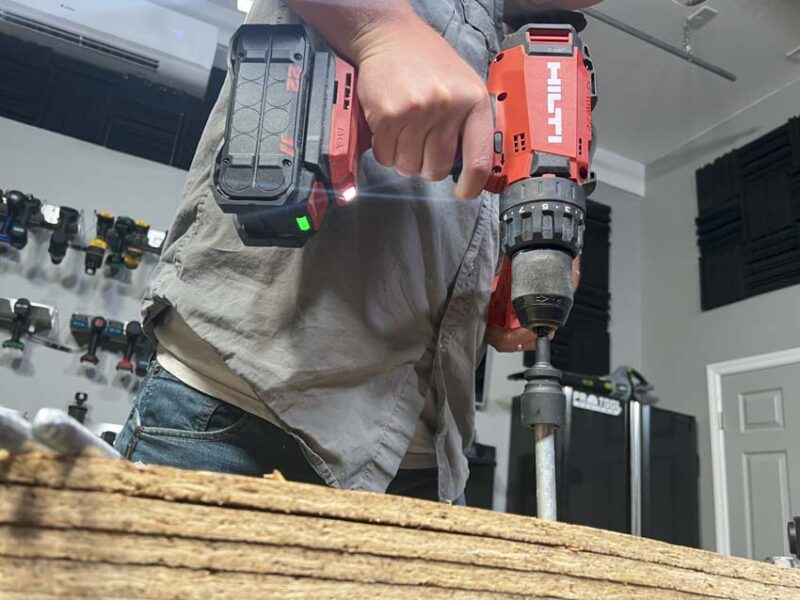

- Speeds: 0 – 300/560/1,300/2,230 RPM
- Max Hammer Rate: NA
- Max Torque: 1,062 in-lbs
- Length: 9.5 inches
- Weight: 4.8 lbs bare, 7.7 lbs with a 7.9Ah battery
| 7.9Ah Battery (vs Primary Batteries Only) |
7.9Ah Battery (vs Primary and Advanced Batteries) |
|
| Soft Torque | 697 in-lbs (1st place) | 697 in-lbs (1st place) |
| Spade Bit | 2.91 sec (4th place) | 2.91 sec (7th place) |
| Self-Feed Bit | 2.83 sec (4th place) | 2.83 sec (7th place) |
| Concrete Bit | 5.51 sec (13th place) * | 5.51 sec (16th place)* |
We know that people use their cordless drills to mix frequently, but Hilti was the first brand we saw intentionally build a cordless drill for this purpose while maintaining the full capabilities of other drill drivers. The 4-mode SF 10W-22 ATC has a low-speed mixing gear that delivered more torque than anything else we tested came close to. Hilti’s addition of ATC kickback control is particularly helpful with that much torque on board.
When standard drilling and driving tasks are on the docket, the top three gears take over and there’s plenty of speed and power on the top end.
As we saw from the previous cordless lineup, Hilti does not include a hammer drilling mode on this model, so we certainly can’t fault its performance in our concrete drilling tests. If you want a drill driver that includes a hammer drilling mode, Hilti’s SF 6H-22 is your best bet on the Nuron platform. With Hilti’s expertise in the concrete industry, the next logical step up from there for concrete drilling is into the cordless rotary hammers.
As an extremely powerful drill, this is another model that’s on the heavy side, especially with the 2P 7.9Ah battery. However, you can shave some weight with the 1P 4.0Ah pack. It’s also the second longest in our tests. But, like other brands, there are more compact models you can add as a supplement when space is tight.
Price: $289
Kobalt 24V XTR Brushless Hammer Drill KXHD 1424A-03


- Speeds: 0 – 550/2,000 RPM
- Max Hammer Rate: 32,000 BPM
- Max Torque: 1,200 in-lbs
- Length: 7.6 inches
- Weight: 3.2 lbs bare, 4.9 lbs with a 4.0Ah Ultimate Output battery
| 4.0Ah Ultimate Output Battery (vs Primary Batteries Only) |
4.0Ah Ultimate Output Battery (vs Primary and Advanced Batteries) |
|
| Soft Torque | 317 in-lbs (10th place) | 317 in-lbs (13th place) |
| Spade Bit | 3.67 sec (8th place) | 3.67 sec (11th place) |
| Self-Feed Bit | 7.30 sec (13th place) | 7.30 sec (16th place) |
| Concrete Bit | 4.54 sec (9th place) | 4.54 sec (12th place) |
Kobalt’s XTR hammer drill was a big step forward for the Lowe’s exclusive brand. In addition to higher performance, it also gave us kickback control—a luxury most value-focused brands didn’t have at the time.
While this model didn’t light up our tests the way some of the other drills did, it proved itself to be capable of handling all our tasks without pushing close to its limits. Both the weight and size are reasonable, and it’s hard to argue with the price.
Price: $269
Makita 40V max XGT Brushless Hammer Drill GPH01
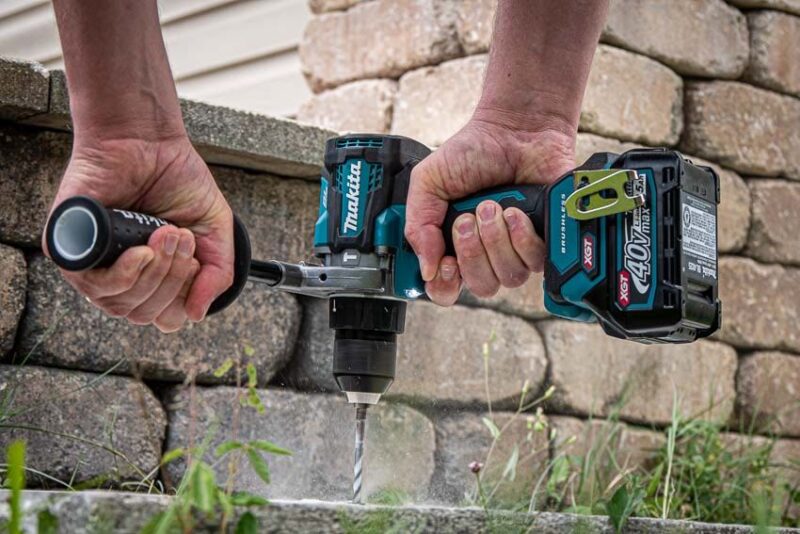

- Speeds: 0 – 650/2,600 RPM
- Max Hammer Rate: 39,000 BPM
- Max Torque: 1,250 in-lbs
- Length: 7.2 inches
- Weight: 3.7 lbs bare, 5.3 lbs with a 2.5Ah battery
| 2.5Ah Battery (vs Primary Batteries Only) |
2.5Ah Battery (vs Primary and Advanced Batteries) |
|
| Soft Torque | 428 in-lbs (5th place) | 428 in-lbs (8th place) |
| Spade Bit | 2.64 sec (2nd place) | 2.64 sec (4th place) |
| Self-Feed Bit | 2.12 sec (1st place) | 2.12 sec (1st place) |
| Concrete Bit | 4.22 sec (8th place) | 4.22 sec (11th place) |
Makita ended up with a mixed bag of results. It delivered excellent power and speed. And it got even better as the load increased. Nonetheless, its ranking in concrete drilling was a bit of a head-scratcher, with speed and blow rate ratings that should have been higher up the list. However we ran multiple tests and used averages to help us identify issues and outliers, and the numbers were consistent.
Like Hilti, Makita runs deep in concrete tools. As such, if drilling in concrete is one of your primary tasks, one of Makita’s cordless rotary hammers should be on your list. For that reason, the lower concrete drilling results don’t dissuade me from recommending this model with enthusiasm.
What you can’t tell from our test results is how smooth this drill is. Ergonomically, it’s excellent with a shape that’s comfortable to hold. Plus, the size is compact for its performance level, and the weight is lower than you’d expect from a 40V max battery system.
As for features, Makita includes kickback control on this model. For those of you who are more OCD in driving mode, there are 41, yes 41, electronic clutch settings in low speed and 21 settings in high gear. Having that many settings and electronically controlling them are characteristics you won’t find on other drills we tested.
If you’re thinking about jumping on Makita’s 40V max XGT system (or you’re already on it), the GPH01 is just one of many tools that will confirm you’re making a great choice.
Price: $499
Ridgid 18V Brushless High-Torque Hammer Drill R861152


- Speeds: 0 – 550/2,000 RPM
- Max Hammer Rate: 32,000 BPM
- Max Torque: 1,250 in-lbs
- Length: 7.3 inches
- Weight: 3.4 lbs bare, 5.0 lbs with a 4.0Ah Max Output battery
| 4.0Ah Max Output Battery (vs Primary Batteries Only) |
4.0Ah Max Output Battery (vs Primary and Advanced Batteries) |
|
| Soft Torque | 218 in-lbs (12th place) * | 218 in-lbs (15th place)* |
| Spade Bit | 4.27 sec (12th place) | 4.27 sec (15th place) |
| Self-Feed Bit | 6.42 sec (8th place) | 6.42 sec (11th place) |
| Concrete Bit | 5.32 sec (10th place) | 5.32 sec (13th place) |
Ridgd’s most recent brushless drills have been a breath of fresh air since leaving the Octane line behind. Even with the High-Torque R861152 model, it’s much more compact and lighter than we’ve been used to from Ridgid, making for a more pleasant user experience.
The results were not what we were hoping for, though the drill had no trouble completing our tests in the slightest. However, we suspect that stepping up to the 6.0Ah Max Output battery will help it step up.
Price: $199
Craftsman V20 Brushless Hammer Drill CMCD721
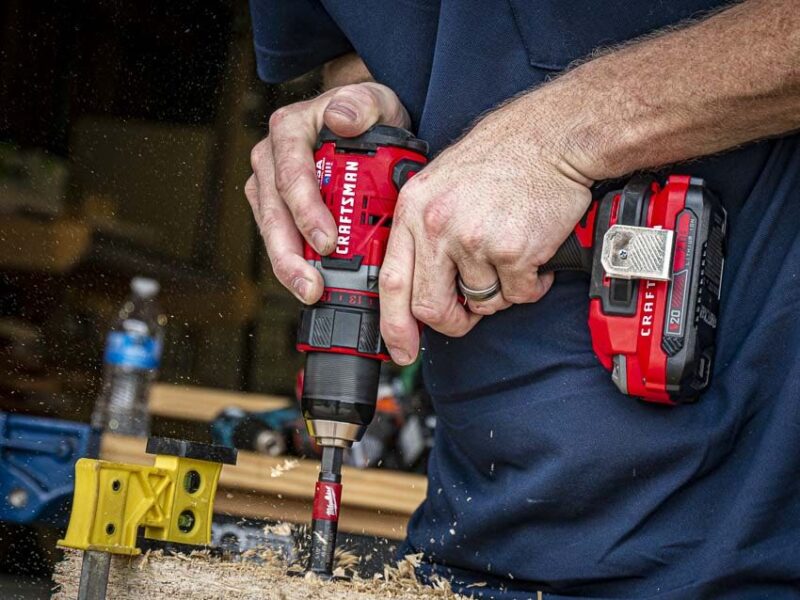

- Speeds: 0 – 600/2,100 RPM
- Max Hammer Rate: 35,700 BPM
- Max Power: 400 UWO
- Length: 7.9 inches
- Weight: 2.7 lbs bare, 4.1 lbs with a 4.0Ah battery
| 4.0Ah Battery (vs Primary Batteries Only) |
4.0Ah Battery (vs Primary and Advanced Batteries) |
|
| Soft Torque | 213 in-lbs (13rd place) | 213 in-lbs (16th place) |
| Spade Bit | 9.96 sec (13th place) | 9.96 sec (16th place) |
| Self-Feed Bit | 6.73 sec (10th place) | 6.73 sec (13th place) |
| Concrete Bit | 4.78 sec (10th place) | 4.78 sec (13th place) |
Craftsman’s big win is that it’s the lightest drill we tested. That’s significant for those of you looking for a quality DIY/Prosumer option. While its overall performance was the lowest for that group, keep it in context. It was able to complete our tests without feeling strained. That said, there are plenty of other drills we didn’t bring in that would have struggled or failed to complete some of the runs.
Price: $199
Hercules 24V Brushless Hammer Drill HCB92B


- Speeds: 0 – 550/2,000 RPM
- Max Hammer Rate: 32,000 BPM
- Max Torque: 1,200 in-lbs
- Length: 7.2 inches
- Weight: 3.3 lbs bare, 5.2 lbs with a 5.0Ah battery
| 5.0Ah Battery (vs Primary Batteries Only) |
5.0Ah Battery (vs Primary and Advanced Batteries) |
|
| Soft Torque | 395 in-lbs (7th place) | 395 in-lbs (10th place) |
| Spade Bit | 3.78 sec (9th place) | 3.78 sec (12th place) |
| Self-Feed Bit | 6.89 sec (11th place) | 6.89 sec (14th place) |
| Concrete Bit | 4.06 sec (5th place) | 4.06 sec (8th place) |
Harbor Freight made bold claims about the performance of its latest Hercules hammer drill. To its credit, it did outperform the others in the DIY/Prosumer class. Targeting Milwaukee’s Gen 4 M18 Fuel hammer drill as a comparison in its marketing, it failed to beat that model in any of the tests and was significantly far behind with the soft torque and self-feed bit. However, it was within sight of the other two.
Compared to the other flagship drills in our test, Hercules does a nice job of keeping the weight and size on the lower side of the scale.
We haven’t used this drill enough to make a recommendation on its long-term reliability. However, Harbor Freight now offers a 5-year warranty that’s sure to raise eyebrows. Nevertheless, Harbor Freight lists it as a professional hammer drill. I’m not convinced it’s ready for that designation. But, for DIY use, it’s an attractive option.
Price: $79.99
Skil PWRCore 20 Brushless Hammer Drill HD5295-1A


Note: At the time of writing, the Skil HD5295 was not available at any retailers. We’re still including in the results because it was the top-performing drill in the DIY/Prosumer class and still points to Skil as a quality choice.
- Speeds: 0 – 500/2,000 RPM
- Max Hammer Rate: 32,000 BPM
- Max Torque: 859 in-lbs
- Length: 7.6 inches
- Weight: 3.3 lbs bare, 4.8 lbs with a 4.0Ah battery
| 4.0Ah Battery (vs Primary Batteries Only) |
4.0Ah Battery (vs Primary and Advanced Batteries) |
|
| Soft Torque | 347 in-lbs (9th place) | 347 in-lbs (12th place) |
| Spade Bit | 3.87 sec (10th place) | 3.87 sec (13th place) |
| Self-Feed Bit | 6.04 sec (7th place) | 6.04 sec (10th place) |
| Concrete Bit | 4.91 sec (11th place) | 4.91 sec (14th place) |
Skil sets itself apart in the Prosumer and DIY class by outperforming its competitors from Ryobi and Craftsman. While it’s not the most compact or lightest of the three, it’s still very reasonable in both departments.
Two features also jump out that push Skil over the top. The battery includes a USB port for charging your devices. It’s a super-handy value add that you can take advantage of at home or on the road.
Skil also packs their kit with a PWRJump charger. It gives a super-fast initial charge to 25% so you can wrap up projects you’re close to finishing. Then it charges at a rapid rate to 80% before tapering off to complete the job. It gets you back in the game quicker and doesn’t hurt the overall life of your battery.
Price: Unavailable
More Cordless Drill Recommendations
Not every drill we’ve used went through our full suite of flagship testing. However, after putting them to use, they’re certainly worth your consideration.
Greenworks 24V Brushless Drill Driver
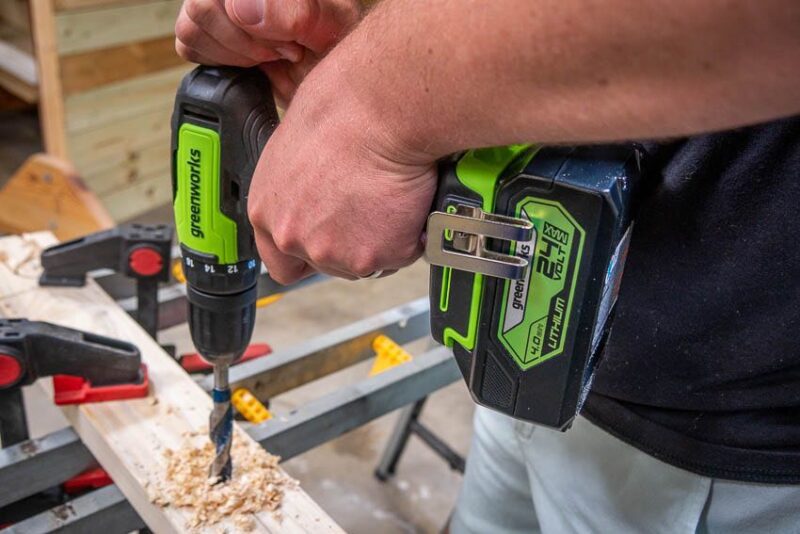

If you’re looking for a drill to use around the house for DIY projects, Greenworks has a 24V brushless model worth considering. It’s a 2-speed model with 1,450 RPM on the top end and 310 in-lbs of torque. This model is reasonably lightweight. Furthermore, it has batteries that double as USB power supplies to charge your devices on the go.
Thinking about going with battery power for your lawn care tools (or maybe you already have)? These tools work with the same batteries Greenworks uses in its 24V and 2 x 24V outdoor power equipment.
Numbers to Know
- Speeds: 0 – 380/1,450 RPM
- Max Torque: 310 in-lbs
- Bare Weight: 2.3 pounds
Price: $129.99 with two 1.5Ah batteries and a charger
Ingersoll Rand IQV20 Cordless Drill D5241
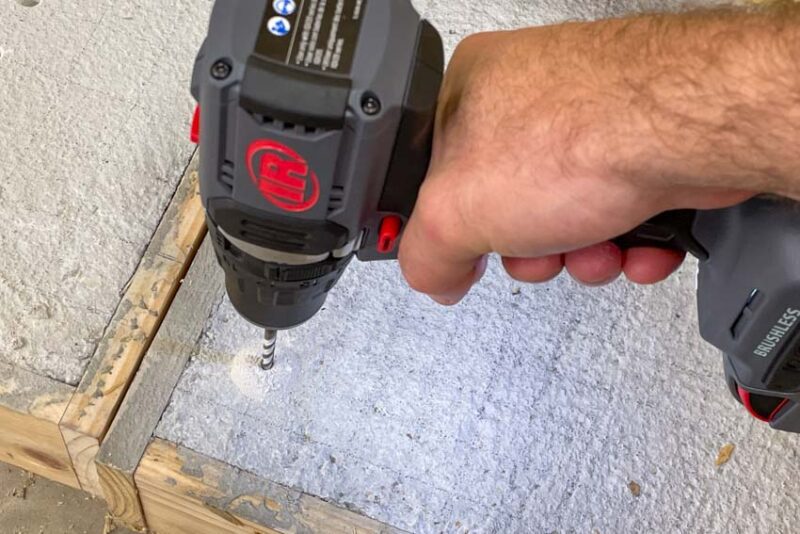

Ingersoll Rand brings their focus on extreme reliability into the cordless drill sector with a couple of options. Our favorite is the D5241 hammer drill. This model’s gearing steps down the speed a little while stepping up the torque to 1100 in-lbs. While the numbers may not seem quite as eye-popping as some models, the durability of the build is what sets Ingersoll Rand’s design apart.
Numbers to Know
- Speeds: 0 – 500/1,800 RPM
- Max Blow Rate: 28,000 BPM
- Max Torque: 1,100 in-lbs
- Head Length: 7.8 inches
- Bare Weight: 3.5 pounds
Price: $199.99 bare tool, $399.99 with two 5.0Ah batteries and a charger
Metabo HPT 36V Brushless DV36DA


Metabo HPT’s 36V MultiVolt hammer drill has the advantage of using a 36V battery that also works with their 18V tools. Plus, you can add an AC adapter if you’d like to have corded power as an option. As a member of the high-torque class, you get 1,220 in-lbs to work with in low gear and a quick 2,100 RPM/31,500 BPM in high gear.
Add in solid ergonomics, the safety of kickback control, and a lifetime warranty, and you get a hammer drill that’s a solid performer for professional contractors.
Numbers to Know
- Speeds: 0 – 500/2,100 RPM
- Max Blow Rate: 31,500 BPM
- Max Torque: 1,220 in-lbs
- Head Length: 8.1 inches
- Bare Weight: 4.5 pounds
Price: $189.00 bare, $289.00 kit with two 4.0Ah batteries and a charger
Skil PWRCore 20 Brushless Compact Hammer Drill HD6294B-10
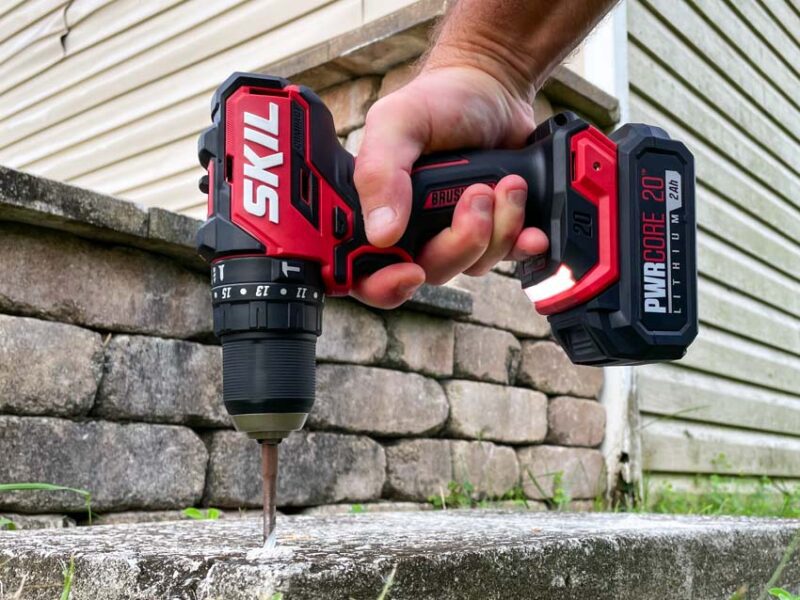

Even though Skil’s PWRCore 20 Brushless Compact Hammer Drill isn’t in the same class as the other drills in our tests above, it’s worth serious consideration. It has a compact, lightweight design, yet still has the power to complete the majority of weekend projects and DIY repairs around your home. And if you don’t need the hammer drilling mode, the drill driver version (DL6293B-10) is even more compact and has a price tag under $100.
Numbers to Know
- Speeds: 0 – 500/1,800 RPM
- Max Blow Rate: 27,000 BPM
- Max Torque: 450 in-lbs
- Head Length: 6.6 inches
- Bare Weight: 2.0 pounds
Price: $129 kit with a 2.0Ah battery and charger
Best Cordless Drill Numbers to Know
Battery Selection
There’s no way to ensure every drill has the same capacity battery. We’re dealing with multiple voltages and there are more advanced battery packs on the market to consider as well. We did the best we could to keep every model working with a 2P pack. For most brands, that’s somewhere in the 4.0Ah to 6.0Ah range. Here are the batteries we tested:
| Model | Primary Battery | Secondary Battery |
| Bosch GSB18V-1330CN | Core 18V 6.3Ah (113.4Wh) |
|
| Craftsman CMCD721 | 4.0Ah (72Wh) |
|
| DeWalt DCD999 | 5.0Ah (90Wh) |
FlexVolt 6.0Ah (108Wh) |
| Flex FX1271 | 5.0Ah (90Wh) |
Stacked Lithium 6.0Ah (108Wh) |
| Hercules HCB92B | 5.0Ah (90Wh) |
|
| Hilti SF 10W-22 ATC | 7.9Ah (142.2Wh) |
|
| Kobalt KXHD 1424A-03 | Ultimate Output 4.0Ah (72Wh) |
|
| Makita GPH01 | 2.5Ah (90Wh) |
|
| Metabo BS 18 LTX-3 BL Q I | LiHD 8.0Ah (144Wh) |
|
| Milwaukee 2904 | 5.0Ah (90Wh) |
High Output 6.0Ah (108Wh) |
| Ridgid R861152 | Max Output 4.0Ah (72Wh) |
|
| Ryobi PBLHM101 | High-Performance 4.0Ah (72Wh) |
|
| Skil HD5295-1A | 4.0Ah (72Wh) |
Editor’s Note: We recharged each battery to full capacity before beginning each test.
Weight
Weight is straightforward but important. Indeed, the lower the weight, the less fatiguing it is to use the drill, especially on overhead applications. Here are the weights we measured, starting with the lowest weight using the primary battery and going up from there:
| Model | Bare Weight | Weight with Primary Battery |
Weight with Advanced Battery |
| Craftsman CMCD721 | 2.7 lbs | 4.1 lbs | |
| Ryobi PBLHM101 | 3.0 lbs | 4.6 lbs | |
| Skil HD5295-1A | 3.3 lbs | 4.8 lbs | |
| Kobalt KXHD 1424A-03 | 3.2 lbs | 4.9 lbs | |
| Milwaukee 2904 | 3.2 lbs | 4.9 lbs | 5.7 lbs |
| DeWalt DCD999 | 3.6 lbs | 4.9 lbs | 5.9 lbs |
| Ridgid R861152 | 3.4lbs | 5.0lbs | |
| Hercules HCB92B | 3.3 lbs | 5.2 lbs | |
| Makita GPH01 | 3.7 lbs | 5.3 lbs | |
| Bosch GSB18V-1330CN | 4.2 lbs | 5.9 lbs | |
| Flex FX1271 | 3.8 lbs | 5.9 lbs | 6.1 lbs |
| Metabo BS 18 LTX-3 BL Q I | 3.9 lbs | 6.1 lbs | |
| Hilti SF 10W-22 ATC | 4.8 lbs | 7.7 lbs |
Length
Lighter weight and a smaller size tend to hand-in-hand. Models that swap out plastic components for more durable metal ones can beef up in a hurry, so it’s no guarantee. A more compact cordless drill gives you the advantage of working in tighter spaces.
| Model | Head Length |
| Milwaukee 2904 | 7.1 in |
| Hercules HCB92B | 7.2 in |
| Makita GPH01 | 7.2 in |
| Flex FX1271 | 7.3 in |
| Ridgid R861152 | 7.3 in |
| Ryobi PBLHM101 | 7.5 in |
| Kobalt KXHD 1424A-03 | 7.6 in |
| Skil HD5295-1A | 7.6 in |
| Craftsman CMCD721 | 7.9 in |
| Bosch GSB18V-1330CN | 8.3 in |
| DeWalt DCD999 | 8.4 in |
| Hilti SF 10W-22 ATC | 9.5 in |
| Metabo BS 18 LTX-3 BL Q I | 9.8 in |
Specifications
To get a general idea of a drill’s performance, the speed offers an idea of how fast you can drill while the torque is an indicator of how strong it is. For hammer drills, the hammer rate (or blow rate) tells you how fast the chipping action is while using hammer mode.
Keep in mind that the speed is based on having no load on the tool. Once you start drilling or driving, the motor has to work hard to keep the speed up. Drills with stronger motors and more efficient energy transfer can outperform models with higher specifications—which is why we test.
| Model | Max Speeds | Max Hammer Rate | Max Torque |
| Bosch GSB18V-1330CN | 550/2,200 RPM | 30,000 BPM | 1300 in-lbs |
| Craftsman CMCD721 | 600/2,100 RPM | 35,700 BPM | 400 UWO ** |
| DeWalt DCD999 | 450/1,300/2,000 RPM * | 38,250 BPM | 1219 UWO ** |
| Flex FX1271 | 700/2,500 RPM | 32,000 BPM | 1400 in-lbs |
| Hercules HCB92B | 550/2,000 RPM | 32,000 BPM | 1200 in-lbs |
| Hilti SF 10W-22 ATC | 300/560/1,300/2,230 RPM | NA | 1062 in-lbs |
| Kobalt KXHD 1424A-03 | 550/2,000 RPM | 32,000 BPM | 1200 in-lbs |
| Makita GPH01 | 650/2,600 RPM | 39,000 BPM | 1250 in-lbs |
| Metabo BS 18 LTX-3 BL Q I | 500/2,050/3,800 RPM | 32,300 BPM | 1062 in-lbs |
| Milwaukee 2904 | 500/2,100 RPM | 33,000 BPM | 1400 in-lbs |
| Ridgid R861152 | 550/2,000 RPM | 32,000 BPM | 1250 in-lbs |
| Ryobi PBLHM101 | 500/2,100 RPM | 31,000 BPM | 750 in-lbs |
| Skil HD5295-1A | 550/2,000 RPM | 32,000 BPM | 859 in-lbs |
* DeWalt’s DCD999 runs at higher 500/1500/2250 RPM speeds when in hammer drilling mode.
** Note that DeWalt and Craftsman spec the power of their drill in unit watts out rather than in-lbs of torque.
How We Tested and Full Results
Soft Torque Test
There’s no great to test maximum torque on a drill—trust me, we’ve built several rigs trying. What we finally settled on is using an in-line torque meter between the drill and nutsetter to measure the maximum torque as we drive a large lag screw into stacked OSB.
It’s a tough test designed to force each drill to stop while measuring the top torque it produces. However, there’s a flaw. Modern brushless motors are designed to sense when things aren’t quite right and shut down to protect themselves. Out test isn’t capable of measuring the full hard-stop torque that’s in the specifications, but it does give us an idea of how much torque the motor is willing to provide in a soft-stop setting.
| Model | Measured Soft Torque Using the Primary Battery |
| Hilti SF 10W-22 ATC | 697 in-lbs |
| Milwaukee 2904 | 539 in-lbs |
| Bosch GSB18V-1330CN | 514 in-lbs |
| Metabo BS 18 LTX-3 BL Q I | 430 in-lbs |
| Makita GPH01 | 428 in-lbs |
| Flex FX1271 | 425 in-lbs |
| Hercules HCB92B | 395 in-lbs |
| DeWalt DCD999 | 380 in-lbs |
| Skil HD5295-1A | 347 in-lbs |
| Kobalt KXHD 1424A-03 | 317 in-lbs |
| Ryobi PBLHM101 | 266 in-lbs |
| Ridgid R861152 * | 218 in-lbs |
| Craftsman CMCD721 | 213 in-lbs |
* After retesting and getting similar results, we believe Ridgid’s brushless motor protection kicked in earlier than the other drills in this test and that it is not representative of its actual real-world performance.
| Model | Measured Soft Torque Using an Advanced Battery |
| Milwaukee 2904 (HO 6.0Ah) | 591 in-lbs |
| Flex FX1271 (SL 6.0Ah) | 549 in-lbs |
| DeWalt DCD999 (FV 6.0Ah) | 468 in-lbs |
Spade Bit Test
In the first of our timed tests, we used a 1-inch self-feeding spade bit to drill through 4 inches of stacked glued USB subfloor to test the medium-load capacities of each drill. We started the test at high speed. If a drill was unable to complete the test, we dropped it into low gear. The result is the average of three successful runs without a bind-up.
| Model | Average Speed w/Primary Battery |
| Metabo BS 18 LTX-3 BL Q I | 2.20 sec |
| Makita GPH01 | 2.64 sec |
| Flex FX1271 | 2.82 sec |
| Hilti SF 10W-22 ATC | 2.91 sec |
| Milwaukee 2904 | 3.36 sec |
| Bosch GSB18V-1330CN | 3.39 sec |
| DeWalt DCD999 | 3.39 sec |
| Kobalt KXHD 1424A-03 | 3.67 sec |
| Hercules HCB92B | 3.78 sec |
| Skil HD5295-1A | 3.87 sec |
| Ryobi PBLHM101 | 3.92 sec |
| Ridgid R861152 | 4.27 sec |
| Craftsman CMCD721 | 9.96 sec |
| Model | Average Speed w/Advanced Battery |
| Flex FX1271 (SL 6.0Ah) | 2.44 sec |
| Milwaukee 2904 (HO 6.0Ah) | 2.62 sec |
| DeWalt DCD999 (FV 6.0Ah) | 2.73 sec |
Self-Feed Bit Test
To push the drills into a heavy-load rough-in application, we used a 2 9/16-inch self-feed bit to punch through 2x studs. The best drills were able to complete the test in high gear. Some that didn’t but had the advantage of 3 or more gear settings settled into a mid-range gear, while others had to complete the test in low gear. The results are the averages of three successful runs without bind-ups.
| Model | Average Speed w/Primary Battery |
| Makita GPH01 | 2.12 sec |
| Bosch GSB18V-1330CN | 2.18 sec |
| Milwaukee 2904 | 2.59 sec |
| Hilti SF 10W-22 ATC | 2.83 sec |
| DeWalt DCD999 | 3.58 sec |
| Flex FX1271 | 4.74 sec |
| Skil HD5295-1A | 6.04 sec |
| Ridgid R861152 | 6.42 sec |
| Metabo BS 18 LTX-3 BL Q I | 6.68 sec |
| Craftsman CMCD721 | 6.73 sec |
| Hercules HCB92B | 6.89 sec |
| Ryobi PBLHM101 | 6.93 sec |
| Kobalt KXHD 1424A-03 | 7.30 sec |
| Model | Average Speed w/Advanced Battery |
| Milwaukee 2904 (HO 6.0Ah) | 2.21 sec |
| DeWalt DCD999 (FV 6.0Ah) | 2.31 sec |
| Flex FX1271 (SL 6.0Ah) | 2.47 sec |
Concrete Bit Test
The final test we ran involved drilling a 3/8-inch concrete bit 3 inches deep into cured 4000 PSI concrete using high gear. We used the hammer drilling mode for each drill except Hilti’s, which only has drilling and driving modes. The result is the average of three successful runs without a bind-up.
| Model | Average Speed |
| Metabo BS 18 LTX-3 BL Q I | 2.60 sec |
| Flex FX1271 | 3.44 sec |
| Milwaukee 2904 | 3.74 sec |
| Bosch GSB18V-1330CN | 3.78 sec |
| Hercules HCB92B | 4.06 sec |
| Ryobi PBLHM101 | 4.16 sec |
| DeWalt DCD999 | 4.18 sec |
| Makita GPH01 | 4.22 sec |
| Kobalt KXHD 1424A-03 | 4.54 sec |
| Craftsman CMCD721 | 4.78 sec |
| Skil HD5295-1A | 4.91 sec |
| Ridgid R861152 | 5.32 sec |
| Hilti SF 10W-22 ATC * | 5.51 sec |
Note that Hilti’s model does not have a hammer drilling mode.
| Model | Average Speed w/Advanced Battery |
| Flex FX1271 (SL 6.0Ah) | 2.55 sec |
| DeWalt DCD999 (FV 6.0Ah) | 2.85 sec |
| Milwaukee 2904 (HO 6.0Ah) | 3.38 sec |
Best Cordless Drill Brands
Cordless drills are one of the most fundamental tools you can own, and it’s no surprise that there are a dizzying number of brands in the space. The good news is that there are a lot of trustworthy names. The bad news is that it can be difficult to tell which one you should buy if you’re new to the industry. Not to worry—we’ve got your back!
We recommend each of the brands listed below, and we’ve broken them up into the classes where they typically do their best work.
Professional
- Bosch
- DeWalt
- Festool
- Flex
- Hilti
- Ingersoll Rand
- Makita
- Metabo
- Metabo HPT
- Milwaukee
Entry-Level Professional
Prosumer/Serious DIY
DIY
- Black and Decker
- Greenworks
- HART
- Masterforce
- Worx
Think you know everything? Our How to Use a Drill article might still manage to show you a thing or two.
Best Cordless Drill Buying Guide – What We Look For
Performance: Speed, blow rate, and torque give you an idea of how fast and strong a drill or hammer drill will perform. They’re helpful when you’re comparing data during research, and typically the higher the battery, but it’s the motor’s ability to keep the RPMs high under load that separates them.
Size and Weight: Size and weight tend to go hand-in-hand, with larger drills weighing more. Ideally, we want the lightest and most compact tool that still does the job effectively. That keeps the fatigue to a minimum while maximizing access.
Ergonomics: Beyond the size and weight, how the weight is balanced and how the grip feels in your hands brings the ergonomics full circle. As you narrow down your choices, there’s something to be said for a tool that feels right in your hands.
Features: As you move up from entry-level cordless drills, you should expect more features that make working more convenient than just performance boosts alone. Here’s what to look for:
- Multiple speeds: 2 speeds are a must, more is generally better
- Kickback control: stops the motor if the bit binds up
- Side handle: absolutely necessary on drills with higher torque
- Smart controls: helps with inventory management and tracking, some offer customizable controls
- Interchangeable chucks: switching to a specialized chuck can get you out of a sticky situation
- All-metal chuck: better durability
- LED light: nearly every drill has one, but our favorites put the light(s) around the chuck
- Belt hook: usually reversible, they’re super-helpful when you have materials to carry or you’re climbing a ladder
Why Cordless Drills?
Few power tools are as basic for both professionals and homeowners as cordless drills. At its core, these are hole-making tools. They help us hang pictures, run wiring and plumbing, create pilot holes, and a host of other projects that require a hole in wood, metal, or drywall.
But the best cordless drill does more than that now. Drill clutch settings give us control over screw driving. Hammer modes let us drill smaller holes in concrete and masonry. In short, cordless drills let us drill and drive in almost any material without the need for a cord.
Why You Can Trust Pro Tool Reviews
Ever check out a “review” site and you can’t tell if the author has any real experience with tools or if they’re just “recommending” the Amazon top sellers? That’s not us. We won’t recommend anything unless we’d use it ourselves. It’s all about giving you a legitimate recommendation and our honest opinion of each product.
We’ve been in business since 2008 covering tools, writing reviews, and reporting on industry news in the construction and lawn care industries. Our Pro reviewers work in the trades and have the skills and experience to know whether tools can perform well in the field.
Each year, we bring in and review more than one hundred individual products. Our team will put our hands on hundreds more at media events and trade shows throughout the year.
Pro Tool Reviews consults with innovators in the technology and design of tools to gain a broader grasp of where these products fit and how they work.
We work with more than two dozen professional contractors around the United States who review products for us on real job sites. We consult with them extensively on testing methods, categories, and practical applications.
Our site will provide several hundred pieces of new content this year absolutely free for our readers. That includes objective evaluations of individual tools and products.
The result is information you can trust because of the editorial, scientific, and real-world professional experience we collectively utilize each and every time we pick up and test a tool.





